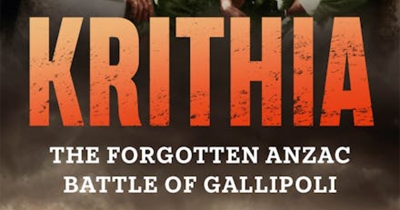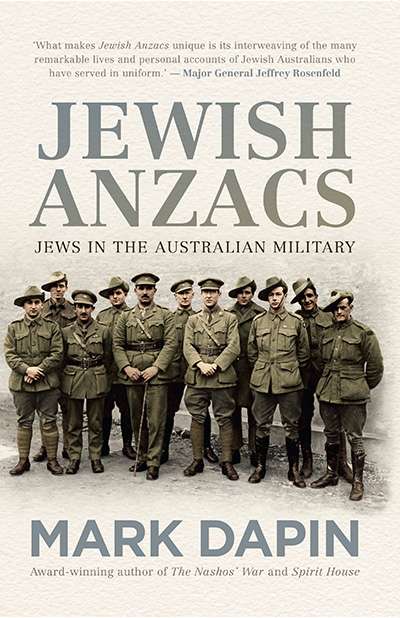Anzacs
Krithia: The forgotten Anzac battle of Gallipoli by Mat McLachlan
The claim of this well-intentioned book is to give an account of the Second Battle of Krithia, which was fought on the Gallipoli Peninsula between 6 and 8 May 1915. However, we do not reach the beginning of the battle until page 187, and it ends on page 257. Thus, we have seventy pages out of 320 on the titular topic of this book.
... (read more)Pilgrimages to war cemeteries have long been part of the rituals of Australian remembrance. It is easy to understand why veterans and the parents and siblings of the men who died in war make these journeys. But why do younger generations do so today, more than a century after World War I and eight decades after World War II? These were not their battles, nor their wars. Why do they seek out the semi-sacred spaces of Commonwealth War Graves Commission (CWGC) cemeteries? And why do they weep over the grave of someone whom they have never met?
... (read more)Shooting Blanks at the Anzac Legend: Australian women’s war fictions by Donna Coates
Near the beginning of Wifedom, Anna Funder describes a disappearing trick whereby a male magician conjures away his female assistant. She uses this as a trope for history’s tendency to make women vanish: ‘Where has she gone?’ Funder asks. This invisibility is especially the case in relation to women and war. Not only are women’s roles in wars downplayed or ignored, but women’s writing on war is seldom regarded as ‘war literature’. As Donna Coates, the author of this newly published study, Shooting Blanks at the Anzac Legend: Australian women’s war fictions, notes, the bookshelves at the Australian War Memorial in Canberra contain numerous books ‘by and about men at war’ and very few examples of women’s war writing.
... (read more)The myth and reality of the Anzac legend has proven a perennial subject of inquiry and argument for over thirty years now, since the publication of Ken Inglis’s justly famous articles in Meanjin and elsewhere in 1964–65. These prompted a spirited exchange with the late Geoff Serle and others. More recently, John Robertson examined the Gallipoli campaign in terms of the myth (1990), and found the critics of Australian martial performance wanting, while Eric Andrews took the Anglo-Australian relationship between 1914 and 1918 to task (1993), and found duplicity and manipulation in the construction of the Australians’ image.
... (read more)The Battlefield of Imperishable Memory: Passchendaele and the Anzac Legend by Matthew Haultain-Gall
This book is about the battles in which the First Australian Imperial Force took part between June and November 1917. It is not, however, a battle history. Rather, it takes the interesting approach of investigating how Australians remember these battles. Spoiler alert: they don’t.
... (read more)Jewish Anzacs: Jews in the Australian military by Mark Dapin
Towards the end of this handsome work, Mark Dapin makes the following observation: ‘There are many more holocaust memoirs written by Jews who emigrated from Europe to Australia than there are personal histories of Australian-born or raised Jewish soldiers. Everywhere in the world the Jewish story is focussed on persecution – the plight of refugees; the unspeakab ...
I hazard a guess that more books are published on Anzac – the day, the legend, the myth – than on any other subject in Australian history. The least of these ...
... (read more)The resurgence of the Anzac legend in the last quarter of the twentieth century took many Australians by surprise. In the aftermath of the Vietnam War, it seemed that the rituals of Anzac Day would wither and fade away as the generations who fought the two world wars died. It proved not to be so. ‘Anzac’, to use the common shorthand, now dominates the national memory of war as strongly as it ever did, although it is not the same legend as it was 100 years ago. Many commentators see this ‘return’ of Anzac as a spontaneous upwelling of national sentiment, a natural and appropriate honouring of those who have died in Australia’s defence. Critics, however, discern a more deliberate orchestration of public sentiment by successive governments, which, for a variety of political purposes, have ‘militarised’ Australian history and sidelined other competing narratives of Australia’s development.
... (read more)Anzac Memories: Living with the legend, Second edition by Alistair Thomson
Be warned! The commemorative tsunami is on its way. As James Brown put it recently in Anzac’s Long Shadow (2014), we are now witnessing an Anzac ‘arms race’, as Australians compete to find ‘bigger and better ways to commemorate our sacrificed soldiers’. The bill to the Australian state and federal taxpayers, Brown calculates, will be nearly $325 million. With a further $300 million projected to be raised in private donations, the commemoration of World War I might ultimately cost some two-thirds of a billion dollars.
... (read more)Anzac’s Dirty Dozen: 12 Myths of Australian Military History edited by Craig Stockings
This book is the second in a series compiled by a group of Canberra academics on the distortions they perceive to surround the writing of military history in this country. Before the book itself is tackled, a word should be said about the titles they have chosen for their two volumes. The first (published in 2010) is called Zombie Myths of Australian Military History; this one is entitled Anzac’s Dirty Dozen: 12 Myths of Australian Military History. As happens to many a poor author, these hideously ugly titles may have been imposed on the book by the publisher. If not, they need serious help when they title future volumes.
... (read more)









